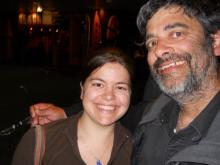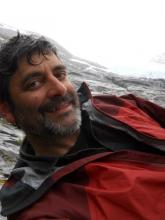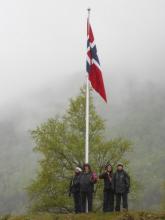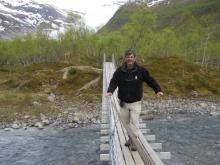What Are They Doing?
Glaciers are like moving rivers of ice, and as meltwater makes its way to the bottom of the ice sheet it acts like a lubricant helping the glacier move. As climate warms in the polar regions, glacial meltwater increases, reduces friction, and causes this movement to increase. Increased glacial movement may cause glaciers to recede more rapidly, but there is no exact formula for this.
For this project, the team worked at the Svartisen Subglacial Laboratory, a laboratory located beneath a glacier, to study the glacier’s movement. From the lab, water pressure beneath the glacier was manually increased in an attempt to cause rapid glacial movement. The sliding of the glacier caused very small earthquakes, which could be measured using seismometers at the glacier surface and in rock tunnels below the glacier.
Predicting future increases in ice-sheet sliding speed is one of the single largest unknowns in predicting sea-level rise due to melting glaciers. The measurements taken were to help scientists learn more about glacial movement. In addition, the information improved how seismological data from the Greenland and Antarctic ice sheets translate to glacial movement, and therefore sea level rise.
Where Are They?
The team lived and worked at the Svartisen Subglacial Laboratory located in northern Norway, slightly north of the Arctic Circle. The Svartisen Glacier is one of the largest glaciers on the Norwegian mainland and the laboratory is situated under some 200 meters of ice. The under-ice laboratory provides researchers the unique opportunity to study the base of the glacier, underlying bedrock, and glacial processes. In addition to being a research station, tunnels in the rock beneath the ice cap have been engineered to direct glacial meltwater water to a nearby hydroelectric power station.
Latest Journals

Neal Iverson is the Smith Family Foundation Chair of the Department of Geological and Atmospheric Sciences at Iowa State University. His research is devoted primarily to understanding glaciers and the spectacular imprint they leave on the landscape. Glacier dynamics and landscape modification are particularly sensitive to processes at glacier beds, which is the focus of much of his effort.
This research involves field experiments at modern glaciers, field measurements in formerly glaciated landscapes, laboratory experiments, and the formulation of models aimed at characterizing glacial processes. He and some of his former students are the 2012 recipients of the Kirk Bryan Award, given by the Geological Society of America for research that advances the field of geomorphology. More information about Dr. Iverson can be found here





